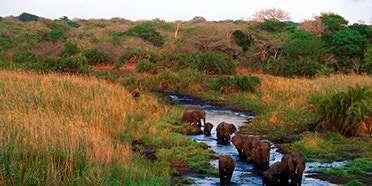- You are here:
- Home
- Countries & Parks
- South Africa Parks
- Tembe Elephant Park
- Reviews
- Expert Reviews
Expert Reviews – Tembe Elephant Park

Stephen is a travel writer and avid conservationist whose work appears in prestigious magazines such as Africa Geographic and Travel Africa.
3 people found this review helpful.
Tuskers of the Sand Forest
In my humble opinion Tembe is nothing short of amazing. If you have time to visit just one game reserve in KwaZulu-Natal, then I would unreservedly recommend it be the meandering sand tracks of this gloriously wild reserve. With only one small lodge within the park and a maximum of ten self-drive 4x4s allowed in per day, Tembe is one of the few game reserves in South Africa that feels truly wild. The 30 013 hectare Tembe Elephant Park is dominated by sand forest and the game-rich Muzi Swamp in the east. It is home to an abundance of wildlife, including wild dogs and a burgeoning lion population (over 40 at last count). But, it is the Tembe’s elephants – and especially its huge tuskers – on which the park has built its reputation. More than 200 of these gentle giants tramp the sandy paths of this pristine wilderness and sightings are all but guaranteed from the hide overlooking Mahlasela waterhole as well as at nearby Mfungeni Pan. Quite aside from the huge buffalo herds, plentiful elephants and abundant general game, the overgrown sandy tracks of Tembe explore one of the last wild tracts of South Africa that still exudes a genuine wilderness feel.

Kim is a travel writer who authored and updated over 15 guidebooks, including Lonely Planet's South Africa and Bradt's Tanzania guides.
2 people found this review helpful.
Walk of the elephants
Located on the border with Mozambique, Tembe Elephant Park is by far the best government-run game park for the Big Five in KwaZulu-Natal. In my opinion, it also comes a pretty close second to Kruger. Beyond the park’s namesake Elephant, the park is also home to larger mammals such as zebra, giraffe, wildebeest and hippo as well as a variety of antelope species including the world’s smallest antelope – the Suni which stands about 12-17 inches high to its shoulder. Noted for its vast swamplands and spectacular sand forests dominated by thickets of tall trees, Tembe is a wild, remote place that is very special indeed. Its true beauty, however, is only revealed if you allow yourself the time to spend a couple of nights in the park.

Ariadne is a renowned African wildlife photographer whose work is featured in many well-known guidebooks and magazines.
2 people found this review helpful.
The sand forest home to South Africa’s last big tuskers
This little-known park bordering Mozambique was proclaimed in 1983 to protect South Africa’s last free-roaming elephants. Today, Tembe is a Big Five Reserve and lots of other wildlife has been reintroduced, but it’s still the elephants that steal the show. These elephants are enormous and they carry seriously big tusks, some of the biggest I’ve ever seen. The best viewing of elephants is from a hide overlooking a large waterhole. One morning, I saw several bulls coming to drink alone or in small groups. A big breeding herd then stayed around for a long time as they enjoyed cooling down in the water.
Aside from giving a home to these special elephants, Tembe’s main importance lies in protecting the largest tract of sand forest in South Africa. This delicate environment is home to an impressive variety of rare flora and fauna and the birding is phenomenal. The gracious nyala is very common and this is also a prime habitat for the secretive red duiker. Even more special is the chance to see one of Africa’s smallest antelopes, the suni. I was lucky to see this shy territorial creature scurrying around camp at dusk.


 South Africa Parks
South Africa Parks